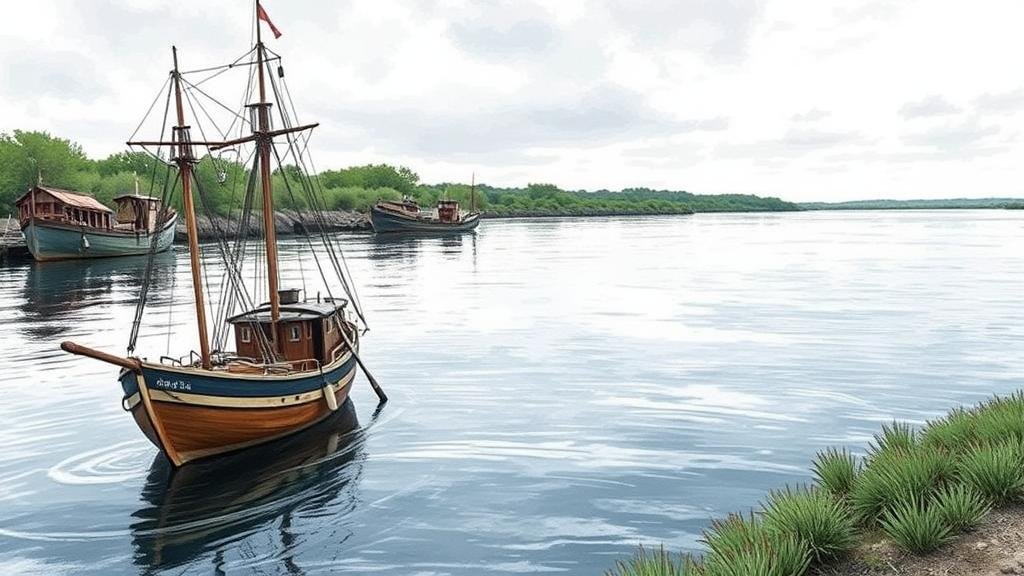Tracing Abandoned River Trade Ports for Nautical Artifact Clues
Tracing Abandoned River Trade Ports for Nautical Artifact Clues
The study of abandoned river trade ports serves as a valuable source of information regarding the evolution of transportation, commerce, and cultural exchange. This research article focuses on the methodologies and outcomes of tracing these historical sites, particularly emphasizing the nautical artifacts recovered and their implications on understanding past maritime activities.
Historical Context of River Trade Ports
River trade ports have been essential to the development of trade routes since ancient times. Notable examples include cities like Venice, Italy, where the Grand Canal served as a bustling trade hub, and the Hudson River ports in New York, pivotal for trans-Atlantic trade in the 18th century. Historical evidence indicates that approximately 70% of global trade during certain periods utilized waterways, underscoring the significance of these ports in facilitating commerce.
According to historical records, many of these ports became abandoned due to factors such as changes in trade routes, industrialization, and natural environmental shifts. For example, the decline of the Whiskey trade in the Ohio River Valley led to the abandonment of several ports by the early 1900s.
The Methodological Approach to Tracing Abandoned Ports
The process of tracing abandoned river trade ports combines archaeological studies with advanced technology like Geographic Information Systems (GIS). Researchers employ various methodologies, ranging from historical document analysis to modern remote sensing techniques, which allow for the identification of past port locations.
- Historical Document Analysis: Researchers review old maps, shipping logs, and port regulations to reconstruct the activities that squared away at these locations.
- Remote Sensing: Techniques such as LiDAR (Light Detection and Ranging) help uncover hidden pathways and structures that may have remained undetected.
These methodologies not only identify prospective sites but also guide archaeologists during field excavations. For example, using historical records of shipwrecks and trade inventories has led to the discovery of previously submerged artifacts that date back to the 17th century.
Nautical Artifacts: What They Reveal
Nautical artifacts recovered from abandoned river ports serve as vital clues to understand historical trade practices, cultural relationships, and technological advancements of their time. These items often include tools, shipbuilding materials, cargo remnants, and navigational instruments.
A notable example includes the recovery of a 19th-century cargo ship hull in the Chicago River, which revealed construction techniques utilized in wooden vessel manufacture, providing insights into material use and shipbuilding patterns of that era.
- Materials and Technologies: An analysis of ship timbers can reveal the selection process of specific wood types, which often correlates with trade relationships with distant forests.
- Cultural Exchanges: Imported artifacts such as pottery or textiles found at these sites illustrate trade routes and cultural interactions between indigenous groups and European settlers.
Case Studies of Successful Discoveries
Several case studies illuminate the potential for significant findings through the study of abandoned river trade ports.
- Hudson River, New York: Excavations along this waterway have uncovered cargo from sunken vessels, including trade goods that elucidate economic transitions from colonial times to the Industrial Revolution.
- Trent-Severn Waterway, Canada: Studies in this area have uncovered artifacts from 19th-century shipping, including navigational tools that help understand maritime laws and practices of the period.
Implications for Future Research
The tracing of abandoned river trade ports and their nautical artifacts has far-reaching implications for various fields including history, archaeology, economics, and anthropology. By reconstructing the past through so-called ‘silent witnesses’ found beneath the water, it is possible to gain a nuanced understanding of maritime heritage.
Plus, the methodologies developed through such investigations can be applied to other historical sites, enhancing their archaeological value. Future research must continue to embrace interdisciplinary approaches and modern technology to ensure the preservation and understanding of our maritime history.
Conclusion
To wrap up, the practice of tracing abandoned river trade ports reveals invaluable insights into historical maritime commerce and cultural exchanges. Through rigorous research methodologies and the recovery of nautical artifacts, we continue to unravel the complexities of our past. Preservation of these sites, alongside further exploration, remains crucial to maintaining our understanding of historical trade dynamics.


